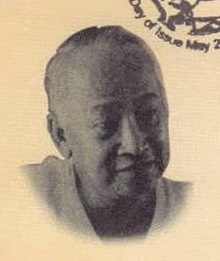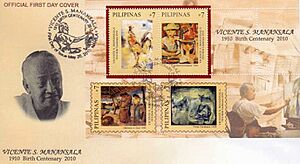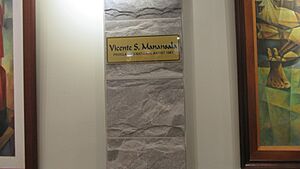Vicente Manansala facts for kids
Quick facts for kids
Vicente Manansala
|
|
|---|---|
 |
|
| Born |
Vicente Silva Manansala
January 22, 1910 Macabebe, Pampanga, Philippine Islands
|
| Died | August 22, 1981 (aged 71) |
| Resting place | Loyola Memorial Park, Marikina |
| Nationality | Filipino |
| Known for | painter and illustrator |
| Movement | Cubism |
| Awards | |
Vicente Silva Manansala (born January 22, 1910 – died August 22, 1981) was a famous Filipino painter and illustrator. He was known for his unique style of Cubism. Cubism is an art style where objects are broken into geometric shapes.
Manansala was one of the first artists in the Philippines to use abstract art. His paintings often showed the changes happening in the country. He showed how city life and country life were connected. He is considered one of the most important Filipino artists in history.
Contents
Early Life and Art Studies
Vicente Manansala was born on January 22, 1910. His birthplace was San Roque, a town in Macabebe, Pampanga. He loved art from a young age.
From 1926 to 1930, he studied at the U.P. School of Fine Arts. This is where he learned many important art skills.
Manansala also got to study art in other countries. In 1949, he received a special grant from UNESCO. This allowed him to study in Canada for six months. He attended the École des Beaux-Arts in Banff and Montreal.
The next year, in 1950, he received another scholarship. The French government gave him nine months to study art in Paris. He also trained at the Otis School of Drawing. These experiences helped him develop his unique painting style.
Manansala's Painting Style
Manansala's art often showed a mix of city and country life. His painting Madonna of the Slums shows a mother and child. They moved from the countryside to live in a city shanty.
His artwork called Jeepneys combines country folk culture with city traffic. He showed how these two parts of Filipino life came together.
Manansala created a special style called transparent cubism. In this style, he used soft colors and shapes. He would layer them on top of each other. This made his paintings look clear and see-through. An example of this style is his painting kalabaw (Carabao).
Vicente Manansala was named a National Artist of the Philippines in Visual Arts. This is a very high honor for artists. He inspired many other Filipino artists. Some of these artists include Malang, Angelito Antonio, and Manuel Baldemor.
You can see Manansala's artworks in many museums. These include the Honolulu Museum of Art and the Lopez Memorial Museum in Manila. The Holy Angel University in Angeles City also has a special collection of his works.
Later Life and Legacy
Vicente Manansala passed away on August 22, 1981. He died in Manila, Philippines. His art continues to be celebrated and studied today.
Famous Works by Manansala
- Madonna of the Slums (1950)
- Machinery
- Jeepneys
- Magsasaka
- Pounding Rice
- Kalabaw (Carabao) (1965)
- Murals "Stations of the Cross" in the Church of the Parish of the Holy Sacrifice
- Bangkusay Seascape (1940)
- Pila Pila sa Bigas (Left and Right) (1980)
- Planting the First Cross
- Slum Dwellers
- Bayanihan
- Balut Vendors
- Pamilya
- Reclining Mother and Child
- Dambana
- The Musicians





